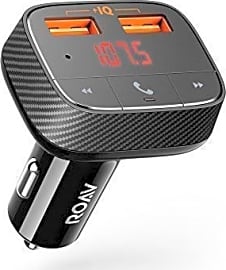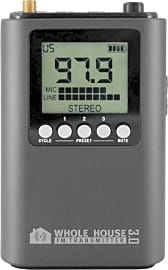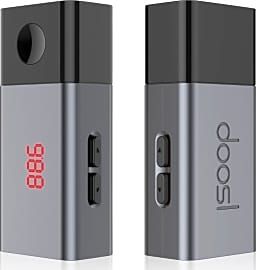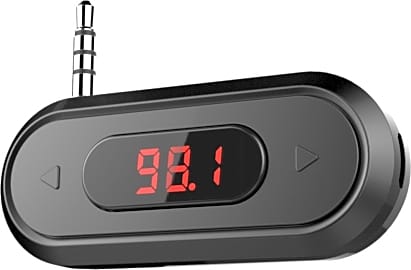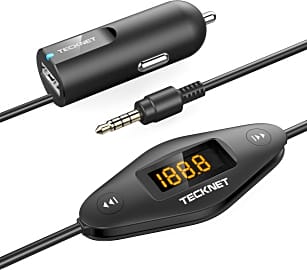The 10 Best FM Transmitters

This wiki has been updated 40 times since it was first published in April of 2015. Just because you don't have an auxiliary or Bluetooth connection in your car doesn't mean you should have to suffer top 40 radio stations during your daily commute. With one of these FM transmitters, you can enjoy music or podcasts from your smartphone, MP3 player, or flash drive in your vehicle, or, using the most powerful options, broadcast anything you like throughout your home or office. When users buy our independently chosen editorial choices, we may earn commissions to help fund the Wiki.
Editor's Notes
December 31, 2020:
We decided to add the Whole House 3.0 in order to accommodate those who are looking to broadcast audio throughout their home or property rather than just their car. While it's a fine solution for an individual who wants to listen to their stereo in every room of the house, its 200-foot range makes it a versatile device that's capable enough for church drive-ins and other such functions. Those interested in such an application may be attracted to more powerful transmitters, but it's important to note that this is one of the few devices of its kind that meets FCC regulations and is not completely illegal to operate in the US. Of course, users should make sure to be familiar with such regulations in order to not accidentally violate them by using an aftermarket antenna or causing interference.
September 06, 2019:
Many FM transmitters designed for in-car use have useful features built in to help you drive with fewer distractions. The GOgroove FlexSmart X2 has volume controls, answer and end-call buttons, as well as play, pause, and skip buttons, so you can change the song or take a call without having to pick up your phone. There is a newer model available, called the FlexSmart X3, but it suffers from several problems, including a finicky auto-scanning function and distortion at high volumes, and the X2 produces better sound quality, so we still recommend the older model. If you want something that takes up less space, the Imden Wireless has a low-profile design that plugs into a cigarette lighter and allows you to charge two devices at once. It doesn't have built-in voice commands, but it does support voice navigation from your device, so you can use it to control your phone with Siri or Google Assistant.
Another compact transmitter with dual USB ports, the Anker Roav SmartCharge F0 features a high-sensitivity microphone with echo cancellation to reduce background noise, making it one of the best options for hands-free calls. While it works with most vehicles, it can interfere with signals from the Tire Pressure Monitoring System in a handful of specific models, including the 2007 Volkswagen Jetta, 2005 Honda Civic, and 2011 Nissan Rogue, so be sure to check that it's compatible with your car before purchasing. The Doosl Modulator has a 700mAh rechargeable battery, so it doesn't need to be plugged in, and it can provide up to 10 hours of playback when fully charged. It's small and lightweight with a Bluetooth range of up to 30 feet, and once you sync it to a device, it automatically connects whenever it's in range.
We've also included the F-S Electronics FSCZH-05B and Retekess TR502 for those looking for long-range transmitters capable of covering large areas. But they are not compliant with the FCC's Title 47 Part 15 regulations, which only allow for a maximum transmission distance of 200 feet, making these devices illegal to operate in the United States. Users should be aware that exceeding this limit can result in a very large fine and can even put you at risk for criminal charges in several states.
Special Honors
F-S Electronics FSCZH-05B The Rangestar from Fail-Safe Electronics is a long-range, 0.5-watt, dual-mode stereo device that can broadcast wirelessly in both high and low power output modes, giving you versatile usage options from up to 100 yards away. Note, however, that it's not approved by the FCC and is illegal to use in the United States. dagcoelectronics.com
Retekess TR502 With an outdoor transmission distance capable of reaching 2-3 kilometers in open air, this is an excellent option for businesses, churches, and outdoor work sites. It features PC control that connects to your computer via USB to interface with intelligent broadcast software. Its range is much longer than the maximum distance of 200 feet allowed by the FCC, though, so this device is not legal to operate in the USA. retekess.com
How An Fm Transmitter Works
Next, you tune your radio to the frequency that corresponds to your transmitter and you’ll hear your music playing loud and clear.
With the emergence of compact digital music players, FM transmitters have become increasingly popular. FM stands for frequency modulation, and this type of transmitter allows portable devices like MP3 players to communicate with an FM radio. They will let you hear all of your favorite songs and podcasts stored on your MP3 player over the bigger-sounding speakers of your car stereo, or any other FM radio you have. Most FM transmitters plug into a headphone jack, so they can work on any device that has a 3.5mm port, though others are designed to interface with microphones and act as office-wide PA systems.
FM transmitters are conveniently compact devices and can often fit into your pocket, and operating them is exceedingly simple. All you have to do is plug them directly into your iPod or similar device, and their converter turns the audio output into an analog audio signal that your FM radio can understand. Next, you tune your radio to the frequency that corresponds to your transmitter and you’ll hear your music playing loud and clear.
In the United States, FM transmitters work within the frequency band of 87.7MHz and 107.9MHz. Certain websites help you find unused channels in your city. You may have to click through all of these channels before finding the one that’s picking up your tunes, but once you’ve found it, you can count on that as your go-to frequency. Outside of that set frequency, your music will interfere with live broadcasts, and you’ll hear a bit of your personal collection, a bit of some mystery show, and a lot of static. Even within the proper frequency, there are still other factors that can interfere with your signal.
The History Of Transmitters
The very first transmitters came out in 1887 and generated radio waves via a high voltage spark between two conductors. These original units could not transmit audio, however, and sent information through radiotelegraphy. They tended to be very noisy, and by the 1920s, vacuum tube transmitters trumped all of these more primitive technologies because they could transmit sound using amplitude modulation, and so the creation of AM radio came about. Modulation in media is the process by which a message signal, like audio, for example, is carried inside of another signal that has the ability to travel.
In 1993, a man named Edwin Armstrong created frequency modulation (FM) transmission, which had less static and less noise than AM. The very first FM radio station came on the air in 1937. This year also saw the emergence of several major radio shows because performers previously-known for their television work finally found radio a suitable medium to explore. W.C. Fields was on his first radio show the “Chase and Sanborn Hour” in 1937, and NBC put out the “Charlie McCarthy Show.”
Special Features To Look For
If you go on a lot of road trips, consider a transmitter with auto scan. As you cross state borders, the corresponding frequency will change, but auto scan will help you quickly find the locally operating one. Another handy feature is preset stations – these let you save the appropriate channel for the cities and states you commonly drive through. For especially long trips, you’ll appreciate a transmitter that has a cigarette lighter adapter with a USB port so you can charge your device on the go.
If you go on a lot of road trips, consider a transmitter with auto scan.
If you want to be able to use your transmitter while moving around – like when you’re on a camping trip and want to control the music from across the site – look for transmitters with larger ranges. Most transmitters only have a 10 to 30-foot range, which is fine if you’re only listening to audio files in your car, but won’t satisfy your needs if you’re walking around your home with your device. The distance between your transmitter and your car’s antenna is also important, which is why it’s best to position your unit in the front of your car. That being said if you want to relax in the back seat while still controlling the music, purchase a model that comes with a remote control.
If you live in a highly populated area, you might struggle to find a clear station to connect to. In this case, look for a model with a wide frequency spectrum. Ideally, your unit offers the full spectrum of channels from 88.1 to 107.9 and doesn’t skip over anything. Some more advanced models have noise filters that remove any static or disruptions to your music. For ease of use, get a unit that has a Radio Data System (RDS). An RDS simply shows information about what you’re listening to – like the name of the song and artist -- on the display screen of your radio. That’s much better than waiting to get 20 seconds into a song before you know if you like it or not.



